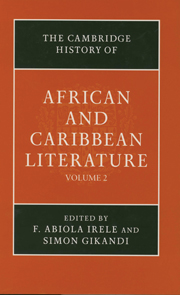Book contents
- Frontmatter
- 23 East African literature in English
- 24 Anglophone literature of Central Africa
- 25 West African literature in English: beginnings to the mid-seventies
- 26 South African literature in English
- 27 African literature in French: sub-Saharan Africa during the colonial period
- 28 North African literature in French
- 29 Francophone literatures of the Indian Ocean
- 30 African literature in Spanish
- 31 African literature in Portuguese
- 32 Popular literature in Africa
- 33 Caribbean literature in French: origins and development
- 34 Caribbean literature in Spanish
- 35 Anglophone Caribbean literature
- 36 The Harlem Renaissance and the Negritude movement
- 37 Postcolonial Caribbean identities
- 38 African literature and post-independence disillusionment
- 39 “Postcolonial” African and Caribbean literature
- 40 Modernism and Postmodernism in African literature
- Index
- References
29 - Francophone literatures of the Indian Ocean
Published online by Cambridge University Press: 28 March 2008
- Frontmatter
- 23 East African literature in English
- 24 Anglophone literature of Central Africa
- 25 West African literature in English: beginnings to the mid-seventies
- 26 South African literature in English
- 27 African literature in French: sub-Saharan Africa during the colonial period
- 28 North African literature in French
- 29 Francophone literatures of the Indian Ocean
- 30 African literature in Spanish
- 31 African literature in Portuguese
- 32 Popular literature in Africa
- 33 Caribbean literature in French: origins and development
- 34 Caribbean literature in Spanish
- 35 Anglophone Caribbean literature
- 36 The Harlem Renaissance and the Negritude movement
- 37 Postcolonial Caribbean identities
- 38 African literature and post-independence disillusionment
- 39 “Postcolonial” African and Caribbean literature
- 40 Modernism and Postmodernism in African literature
- Index
- References
Summary
Off the southeast coast of the African continent and beneath the Equator lie a rather large number of islands that comprise the Comoros, Madagascar, the Mascarenes (Mauritius, Réunion, and Rodrigues), and the Seychelles. The Indian Ocean was created when the original continent of Gondwana split apart, giving birth to Africa, India, Australia, and Antarctica, around 140 million years ago. Geologically, these islands differ greatly. Whereas most of them are vestiges of the driftage from that original continent, others like Réunion and the Comoros are, on the other hand, the result of more recent volcanic eruptions. Their origins explain why these islands, which are relatively close to one another, reveal such great natural diversity, from the “Great Island” of Madagascar which is almost a continent itself (measuring 1,580 km from north to south and only 580 km at its greatest width for an area of 587,041 km2), to the numerous small coral islands of the Seychelles, to Mauritius with its flattened plains (2,100 km2), Réunion (2,512 km2) with the spectacular contours of its volcano and mountains, and Rodrigues (110 km2) which is but a mass of lava. There is nevertheless a similar tropical-variety “island climate” that along with the monsoon has historically allowed for movement between the islands.
- Type
- Chapter
- Information
- The Cambridge History of African and Caribbean Literature , pp. 569 - 583Publisher: Cambridge University PressPrint publication year: 2000
References
- 1
- Cited by

